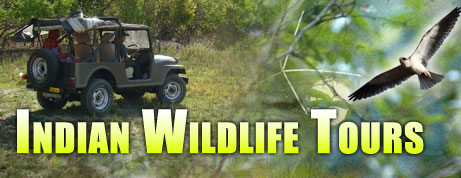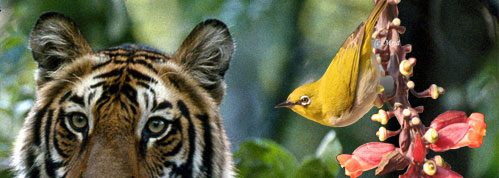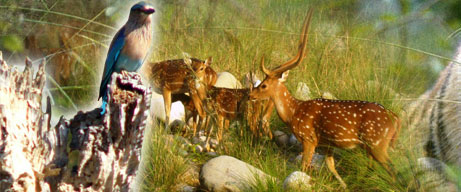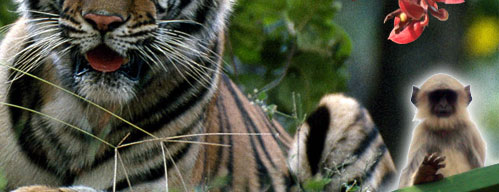Wild Species In India
COBRA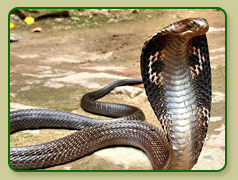
Indian Cobra also known as the 'spectacled cobra' due to spectacle markings on the hood, the Indian cobra is a prominent species of venomous snake among reptiles. In a country like India, the cobra is both respected and feared; it occupies an important place in the Hindu mythology. Indian king cobra can be seen curled around the neck of Lord Shiva in all the temples dedicated to the very lord. Vishnu is also depicted reposing on the body of Sheshnag, the sacred serpent with multiple cobra heads. Even more interesting is the tradition of cobra-and-mongoose fight that still continues in many parts of the country. For snake charmers in India, the cobra happens to be the 'snake of choice'.
Status of Cobra in India
Although the Indian Cobra is not an endangered species, it has recently been hunted for its distinctive hood markings in the production of handbags. It is listed under the treaty because it closely resembles other species that are threatened and in need of protection.
Physical Traits of King Cobra
Indian king cobra has two circular ocelli patterns (connected by a curved line) on the backside of its hood. However, specimens with single ring marking have also been found in the state of Assam and eastern regions of India. An average adult cobra measures between 120 cm and 150 cm. It rarely reaches the length of 210 cm. These oviparous cobras lay 10-24 eggs in the month of May. The newborns of the cobra are a little less than 30 cm in length and are much more aggressive than adults. While being irritated, the cobra raises the front (about 1/3 rd of its body) and spreads its hood; this threat-display posture makes it all the more popular.
Natural History
The Indian cobra feeds on rodents, lizards and frogs. It bites quickly, and then waits while its venom damages the nervous system of the prey, paralyzing and often killing it. Like all snakes, N. naja swallows its prey whole. This species sometimes enters buildings in search of rodent prey. In its characteristic threat posture, the Indian cobra raises the front one-third of its body and spreads out its long, flexible neck ribs and loose skin to form a disklike hood, on the back of which there are markings resembling eyes.
Indian cobras pay more attention to their eggs than is usual in snakes. The 8 to 45 eggs (usually 12 to 20) are laid in a hollow tree, a termite mound or earth into which the snakes tunnel. The female guards the clutch throughout the incubation period, leaving them only for a short time each day to feed.
Cobra in India : - In India, the king Cobra is found in the National Parks and Reserves of -

- class: Reptiles
- Diet: Small mammals, reptiles, amphibians
- Size: Body:1.8 - 2.2 m (6 - 7 1/4 ft)
- Scientific Name: Naja naja
- Habitat: Rainforest, Rice fields, Cultivated land
- Range: India, Central Asia, Southeast Asia
Indian Cobra also known as the 'spectacled cobra' due to spectacle markings on the hood, the Indian cobra is a prominent species of venomous snake among reptiles. In a country like India, the cobra is both respected and feared; it occupies an important place in the Hindu mythology. Indian king cobra can be seen curled around the neck of Lord Shiva in all the temples dedicated to the very lord. Vishnu is also depicted reposing on the body of Sheshnag, the sacred serpent with multiple cobra heads. Even more interesting is the tradition of cobra-and-mongoose fight that still continues in many parts of the country. For snake charmers in India, the cobra happens to be the 'snake of choice'.
Status of Cobra in India
Although the Indian Cobra is not an endangered species, it has recently been hunted for its distinctive hood markings in the production of handbags. It is listed under the treaty because it closely resembles other species that are threatened and in need of protection.
Physical Traits of King Cobra
Indian king cobra has two circular ocelli patterns (connected by a curved line) on the backside of its hood. However, specimens with single ring marking have also been found in the state of Assam and eastern regions of India. An average adult cobra measures between 120 cm and 150 cm. It rarely reaches the length of 210 cm. These oviparous cobras lay 10-24 eggs in the month of May. The newborns of the cobra are a little less than 30 cm in length and are much more aggressive than adults. While being irritated, the cobra raises the front (about 1/3 rd of its body) and spreads its hood; this threat-display posture makes it all the more popular.
Natural History
The Indian cobra feeds on rodents, lizards and frogs. It bites quickly, and then waits while its venom damages the nervous system of the prey, paralyzing and often killing it. Like all snakes, N. naja swallows its prey whole. This species sometimes enters buildings in search of rodent prey. In its characteristic threat posture, the Indian cobra raises the front one-third of its body and spreads out its long, flexible neck ribs and loose skin to form a disklike hood, on the back of which there are markings resembling eyes.
Indian cobras pay more attention to their eggs than is usual in snakes. The 8 to 45 eggs (usually 12 to 20) are laid in a hollow tree, a termite mound or earth into which the snakes tunnel. The female guards the clutch throughout the incubation period, leaving them only for a short time each day to feed.
Cobra in India : - In India, the king Cobra is found in the National Parks and Reserves of -
- Corbett National Park
- Manas Wildlife Sanctuary
- Namdapha National Park
- Sunderbans National Park
